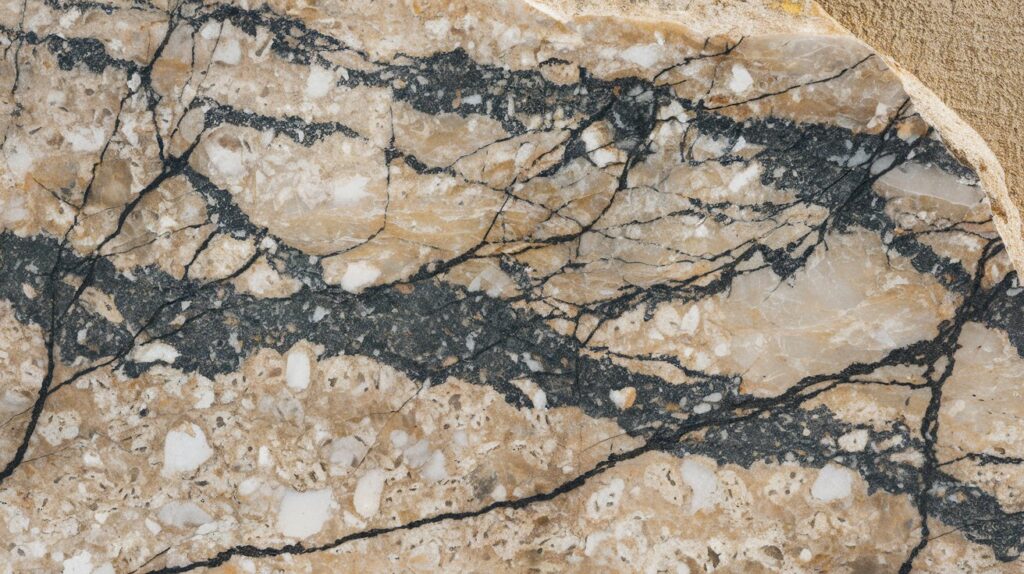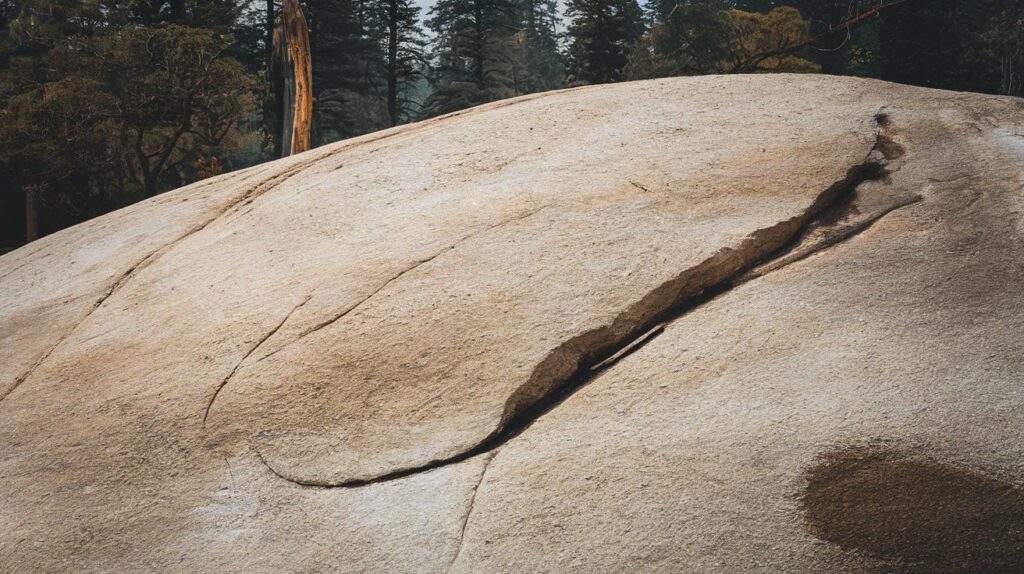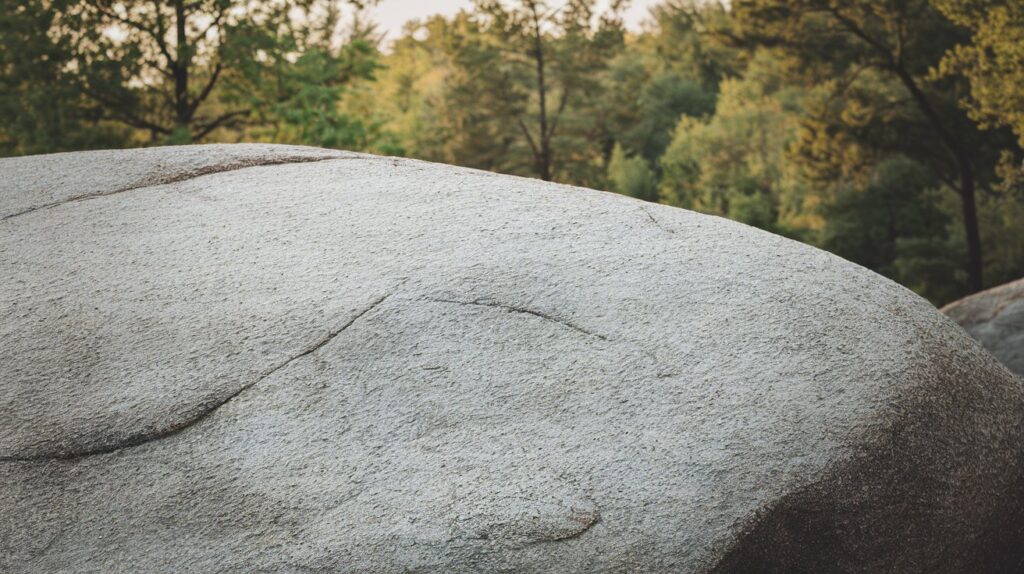
Granite is one of the most popular and widely used rocks in the world. It’s known for its beauty and durability, making it a favorite choice for construction and design. In this post, we will delve into the fascinating world of granite—its composition, characteristics, and various uses.
What is Granite?
Granite is a type of plutonic rock that forms deep within the Earth’s crust. It is primarily made up of three main minerals: quartz, feldspar, and mica. What sets granite apart is its unique composition. Typically, granite contains 10 to 50 percent quartz and a feldspar ratio that usually falls between 65 to 90 percent. This rich mix of minerals gives granite its distinctive appearance and strong physical properties.
Granite is a naturally occurring igneous rock composed mainly of quartz, feldspar, and mica. It forms from the slow crystallization of magma beneath the Earth’s surface, which allows large crystals to develop. This results in its characteristic granular texture.
Granite is known for its durability and strength, making it a popular choice for construction, especially for countertops, flooring, and monuments. It comes in a variety of colors and patterns, depending on its mineral composition. Its resistance to heat and scratching makes it particularly desirable in kitchens and high-traffic areas. Additionally, granite is often associated with a classic, elegant aesthetic in both residential and commercial designs.
What is granite in simple words?
Granite is a type of very hard rock that forms from cooled magma (molten rock) deep inside the Earth. It’s made of different minerals like quartz, feldspar, and mica, which give it a speckled appearance. Granite is commonly used for building things like countertops, floors, and monuments because it’s strong and lasts a long time.
What is granite used for and why?
Granite is used for a variety of purposes because it’s a durable, strong, and attractive material. Here are some common uses and reasons:
- Countertops (Kitchens and Bathrooms): Granite is heat-resistant, scratch-resistant, and easy to clean, making it ideal for countertops.
- Flooring and Tiles: Its durability and natural beauty make it a popular choice for floors in homes and commercial buildings.
- Monuments and Statues: Granite lasts a long time and can withstand weather, so it’s often used for statues and memorials.
- Building Facades and Paving: Because it’s strong and comes in a variety of colors, granite is used to cover the exterior of buildings and as paving stones.
- Bridges and Foundations: Granite is used in construction for its strength and ability to bear heavy loads.
The main reasons for using granite include its strength, resistance to wear and tear, and natural beauty.
What type of rock is a granite?
Granite is an igneous rock. It forms when molten rock (magma) cools and solidifies deep beneath the Earth’s surface. This slow cooling process allows large crystals to develop, giving granite its distinctive coarse-grained texture. Since it’s formed from magma, granite is classified as intrusive igneous rock (meaning it forms inside the Earth’s crust).
What color is granite?
Granite comes in a wide range of colors due to the minerals that make it up. The most common colors of granite are:
- Gray: The most typical granite color, often speckled with black and white minerals.
- White: White granite usually has gray, black, or pink flecks due to the presence of quartz and feldspar.
- Black: Although rarer, some granites are almost entirely black, with shiny mineral inclusions.
- Pink: Pink granite is often caused by a higher concentration of potassium feldspar.
- Red: Similar to pink granite but with more intense red hues.
- Blue: Some exotic granites have bluish tones, usually because of mineral inclusions like labradorite.
- Green: Green granite often contains quartz and other minerals like serpentine.
Granite often has a speckled or patterned appearance, making its colors very dynamic and varied.
How to identify granite?
Identifying granite involves examining its physical and visual characteristics. Here are some steps you can follow to identify granite:
1. Check for Visible Grains
Granite has a grainy texture due to its composition of minerals like quartz, feldspar, and mica. The grains are usually visible to the naked eye and may range in size.
- Quartz: Appears clear or white, often glassy-looking.
- Feldspar: Can appear pink, white, or grey.
- Mica: Gives a shiny, flaky appearance, often black or silver.
2. Look at the Color
Granite is known for its speckled appearance with various colors. Common granite colors include:
- Gray, white, pink, red, black, and green.
- The mix of minerals gives it a multicolored or speckled appearance, often with sharp, irregular patterns.
3. Perform a Hardness Test
Granite is extremely hard and durable. On the Mohs hardness scale, granite typically scores between 6 and 7. You can try scratching the surface with a steel knife:
- If the knife doesn’t leave a mark, it’s likely granite or another hard stone.
- If the stone scratches easily, it may not be granite.
4. Check for Porosity
Granite is less porous compared to other natural stones like marble. To test this:
- Drop a small amount of water on the surface.
- If the water absorbs slowly or doesn’t absorb at all, it’s likely granite. Highly porous stones will absorb water quickly.
5. Inspect for Patterns
Granite often has veins or patterns created by the flow of molten rock during its formation. Look for:
- Interlocking crystals: Unlike uniform, banded stones like marble, granite has a more chaotic, speckled pattern.
- Color variation: Natural granite varies significantly across its surface, with lighter or darker streaks.
6. Test for Acid Resistance
Granite is generally acid-resistant. You can place a few drops of lemon juice or vinegar on the surface:
- If the surface remains unchanged, it’s likely granite.
- If the surface etches or becomes dull, it’s more likely marble or limestone.
7. Check the Weight
Granite is heavier than most other stones due to its density. If you have a sample, compare its weight to other stones of similar size.
By using these techniques, you can determine if a stone is granite based on its texture, color, hardness, porosity, and reaction to acids.
How is granite made?
Granite is an igneous rock that forms from the slow cooling and solidification of magma deep beneath the Earth’s surface. The process of granite formation can be broken down into several stages:
1. Magma Formation
Granite begins as molten rock or magma deep inside the Earth’s crust, often 10–50 kilometers below the surface. This magma forms as a result of intense heat and pressure, typically in areas where tectonic plates are moving apart, colliding, or where the Earth’s mantle is melting.
- Composition of Magma: Granite magma is rich in silica (SiO₂) and contains a mixture of other elements like aluminum, potassium, sodium, and trace amounts of iron and magnesium.
2. Cooling of Magma
As the magma cools slowly beneath the Earth’s surface, it begins to crystallize and solidify, forming the interlocking crystals that make up granite. This slow cooling process is what gives granite its coarse-grained texture, with visible mineral grains.
- Quartz: One of the last minerals to crystallize, giving granite its glassy, clear, or whitish appearance.
- Feldspar: Crystallizes first and makes up most of the rock, contributing to the pink, white, or gray color.
- Mica and Hornblende: These darker minerals form in small quantities and contribute black or dark brown flecks.
3. Intrusion into the Crust (Plutons)
The molten magma remains deep within the Earth, forming large plutons or batholiths—massive bodies of igneous rock. These plutons can be exposed over millions of years through processes like erosion and uplift of the surrounding rocks.
4. Solidification into Granite
Over time, as the magma cools completely, the resulting rock is called granite. It contains interlocking crystals of quartz, feldspar, and mica, which create its characteristic appearance. The composition of these minerals varies, leading to the wide range of colors and patterns seen in different types of granite.
5. Exposure to the Surface
Granite, initially buried deep underground, is gradually exposed at the Earth’s surface through a process called uplift and erosion. Tectonic forces push the granite upward, and over millions of years, the softer surrounding rocks wear away, revealing large granite formations like mountains, cliffs, and boulders.
Summary of the Granite Formation Process:
- Magma formation in the Earth’s crust.
- Slow cooling and crystallization of magma beneath the surface.
- Intrusion of magma into the crust, forming large underground rock bodies (plutons).
- Solidification of the magma into granite.
- Exposure of granite due to tectonic activity and erosion.
This entire process can take millions of years, resulting in the durable, visually striking stone we know as granite today.
Composition of Granite
The composition of granite can vary, but it generally includes the following minerals:
| Mineral | Percentage Range |
|---|---|
| Quartz | 10% – 50% |
| Feldspar | 65% – 90% |
| Mica | 1% – 10% |
| Other | Trace amounts of other minerals |
Key Components of Granite
- Quartz
- Quartz is a hard mineral that contributes to the overall strength of granite. Its glassy appearance adds to the rock’s beauty.
- Feldspar
- This mineral is what gives granite its variety of colors. The two main types of feldspar in granite are orthoclase and plagioclase.
- Mica
- Mica adds a sparkling effect to granite. It can appear in different colors, such as black (biotite) or light (muscovite).

Characteristics of Granite
Granite has several notable characteristics that make it a popular choice in various applications:
- Durability: One of the most durable natural stones, granite is resistant to scratches and wear.
- Heat Resistance: It can withstand high temperatures, making it ideal for kitchen countertops.
- Variety of Colors: Available in a wide range of colors and patterns, granite can fit any design aesthetic.
- Low Maintenance: With proper sealing, granite is easy to clean and maintain.
Granite has several key characteristics that make it a popular choice for various applications:
- Durability: Granite is incredibly hard and resistant to scratches, making it suitable for high-traffic areas and surfaces that endure wear and tear.
- Heat Resistance: It can withstand high temperatures without damage, making it ideal for kitchen countertops.
- Aesthetic Appeal: Granite comes in a wide range of colors and patterns, allowing for unique design options. Its natural beauty adds a touch of elegance to spaces.
- Low Porosity: While not completely non-porous, granite is relatively low in porosity, which helps resist staining and makes it easier to clean with proper sealing.
- Tensile Strength: Granite has excellent tensile strength, which means it can support heavy loads without breaking.
- Natural Variation: Each slab of granite is unique, with variations in color and pattern, which can enhance the individuality of design projects.
- Weather Resistance: It withstands outdoor conditions well, making it suitable for exterior applications like patios and facades.
- Ease of Maintenance: With proper sealing, granite is easy to maintain and clean, requiring only regular wiping with mild soap and water.
These characteristics contribute to granite’s popularity in both residential and commercial construction.
Uses of Granite
1. Construction
Granite is widely used in construction due to its strength and durability. Some common applications include:
- Buildings: Many skyscrapers and monuments are made of granite.
- Pavements: Granite is often used for sidewalks and roads.
- Bridges: Its sturdiness makes it an ideal material for bridge construction.
2. Interior Design
In interior design, granite is favored for its aesthetic appeal and practical benefits:
- Countertops: Granite countertops are a popular choice in kitchens and bathrooms.
- Tiles: Granite tiles can be used for flooring and walls.
- Vanities: Bathroom vanities often feature granite for a touch of elegance.
3. Monuments and Sculptures
Granite is a classic choice for monuments and sculptures due to its long-lasting nature:
- Headstones: Many gravestones are made from granite, ensuring they stand the test of time.
- Statues: Artists often use granite for large outdoor sculptures.
4. Industrial Uses
Beyond construction and design, granite has several industrial applications:
- Gravestones: Due to its durability, granite is commonly used in cemetery markers.
- Machinery: Some machinery bases are made from granite to absorb vibrations.
5. Landscaping
Granite can also be used in landscaping to enhance outdoor spaces:
- Boulders: Large granite boulders can create natural-looking features in gardens.
- Paths: Granite chips can be used for walkways.
Granite is widely used in various applications due to its durability and aesthetic appeal. Here are some common uses:
- Countertops: One of the most popular uses, granite countertops are favored for kitchens and bathrooms due to their heat resistance and scratch durability.
- Flooring: Granite tiles are often used in homes, commercial buildings, and public spaces for elegant, durable flooring.
- Monuments and Headstones: Its longevity makes granite a popular choice for gravestones and memorials.
- Building Facades: Granite is used as a cladding material for buildings, providing a durable and attractive exterior finish.
- Staircases and Steps: Its strength makes granite suitable for both interior and exterior staircases.
- Fireplaces: Granite is often used for fireplace surrounds and mantels, adding a sophisticated look.
- Sinks and Vanities: Granite sinks and vanity tops are popular for their beauty and durability in bathrooms and kitchens.
- Paving Stones: Granite is used for outdoor paving, creating walkways, driveways, and patios.
- Commercial Spaces: Many businesses use granite for countertops in bars, restaurants, and retail spaces due to its professional look.
- Art and Sculpture: Artists often use granite for sculptures and decorative elements, thanks to its workability and permanence.
These uses highlight granite’s versatility, making it a favored material in both functional and decorative applications.
Conclusion
In summary, granite is a versatile and durable rock that is not only beautiful but also functional. Its composition of quartz, feldspar, and mica contributes to its unique characteristics and numerous applications. Whether used in construction, interior design, or landscaping, granite stands out as a top choice for many projects.
Key Takeaways
- Granite is a plutonic rock made primarily of quartz and feldspar.
- It has excellent durability, heat resistance, and low maintenance requirements.
- Granite is used in construction, interior design, monuments, and landscaping.

Important Point
| NO. | Important Points |
| 1. | About Us |
| 2. | Contact Us |
| 3. | Disclaimer |
| 4. | Privacy Policy |
FAQs of Granite
What is the primary composition of granite?
Granite is primarily composed of quartz, feldspar, and mica.
Is granite durable?
Yes, granite is one of the most durable natural stones available.
Can granite be used for outdoor applications?
Absolutely! Granite is commonly used in outdoor constructions and landscaping.
How should I maintain my granite countertops?
Regular cleaning with mild soap and water is sufficient; sealing is recommended every few years.
Does granite come in different colors?
Yes, granite comes in a variety of colors and patterns, thanks to its mineral composition.
Is granite heat resistant?
Yes, granite can withstand high temperatures, making it ideal for kitchen use.
How is granite formed?
Granite forms slowly from the cooling of magma beneath the Earth’s surface.
Can I use granite for flooring?
Yes, granite tiles are a popular choice for both residential and commercial flooring.
Is granite a good choice for monuments?
Yes, its durability makes granite an excellent material for monuments and gravestones.
Are there any eco-friendly options for granite?
Some companies offer reclaimed or recycled granite, which can be a more sustainable option.
